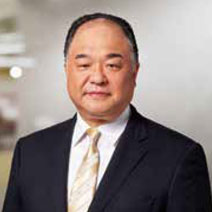Nisshinbo’s R&D Strategy
Promoting Groupwide collaborative research and development activities
Yasuo Imashiro
Managing Officer
General Manager
Business Development
Division

Leveraging Our Group R&D System
The goal of the Nisshinbo Group’s long-term R&D strategy is to provide value for the super smart society by focusing on providing solutions in four areas — hydrogen, mobility, medical & healthcare and public infrastructure. To achieve that goal, we conduct Groupwide collaborative research and development activities, supported by our Group R&D system. Representatives from each business field – wireless and communications, micro devices, brakes and chemicals – meet regularly to drive innovation by bringing together the Group’s businesses.
We are currently working on around 30 cross-business R&D projects. Helium gas sensors, one of the research projects, are closest to commercialization. We started trial sales in the fiscal period ended December 2018 and we plan to launch them officially in 2019. Our sensors, which are designed to detect gas leaks in factories and other environments, are lighter, more compact and significantly cheaper than existing sensors, and can also operate in humid conditions. They are the first portable helium gas sensors on the market. We expect those features to support growth in the number of installed sensors and applications, potentially driving growth in the broader gas sensor market. Our sensors also have the potential to be used as hydrogen gas sensors in future fuel cell vehicles (FCVs).
Basic Policy for 2019
One of the business development division’s priority measures in 2019 is to create and cultivate new businesses and expand its core competences. Currently, representatives from across the Group meet once every two months at a New Business Group Meeting to discuss new business opportunities. Senior and mid-level managers from each of the Group’s core subsidiaries attend the meeting to constructively share information on each business development theme. In addition, we conduct business feasibility studies to assess the prospects of key themes and we are fostering a more entrepreneurial mindset among our researchers. We are also reinforcing intellectual property (IP) management, such as using e-learning programs and other tools to educate employees about the importance of IP.
Fuel Cell Development
Fuel cells are different to batteries, as they generate power using hydrogen fuel and they are likely to gain popularity as a promising alternative source of energy. In the automotive field, electric vehicles (EV) with lithium-ion batteries are currently gaining ground in the market. However, the Japanese government is targeting fuel cell vehicle (FCV) uptake by 2030, and the industry is working to resolve issues that stand in the way of that goal, such as building a network of hydrogen refueling stations.
The Nisshinbo Group is focusing on the development of carbon bipolar plates for fuel cells and carbon alloy catalysts as a replacement for fuel cell platinum catalysts. We are now working on developing thicker, more durable bipolar plates to support widespread use in automotive applications. Meanwhile, we are deepening collaboration with Ballard Power Systems, Inc., a leading fuel cell manufacturer in Canada. Our bipolar plates have already been selected for the company’s fuel cells used in forklifts and we are now working to drive sales so that our carbon alloy catalysts are also adopted for forklifts.

